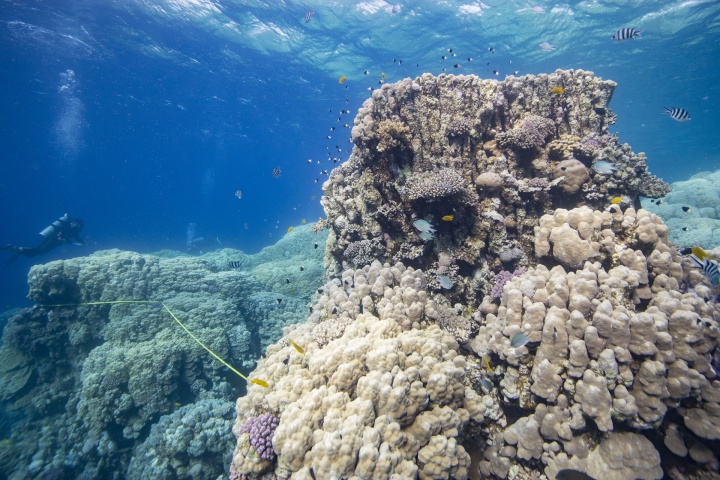New study uncovers more causes of coral bleaching

Photo credit: Florian Roth
Increased nutrients in the ocean can
accelerate coral bleaching caused by high sea temperatures,
according to new research from University of Waikato Marine
Scientist Joanne Ellis.
Dr Ellis led a scientific expedition in the Red Sea last year to study the causes of coral bleaching for the King Abdullah University of Science and Technology.
When water is too warm, corals will expel the algae living in their tissues causing the coral to turn completely white. This is called coral bleaching, Dr Ellis explains.
“If the high temperatures persist, then the absence of these algae can ultimately cause mortality because the coral is deprived of energy and can become susceptible to diseases,” says Dr Ellis.
Large-scale coral bleaching is increasing due to climate change. The research was prompted by significant coral bleaching observed in the Red Sea in 2015.
“Because 2015 wasn't actually one of the warmest summers on record, yet we were observing these really high rates of bleaching, we wanted to understand what were the factors that may be involved ,” says Dr Ellis.
Her team spent a total of one month cruising the Red Sea taking 60 core samples of corals using a large underwater drill.
“Corals lay down bands similar to how trees lay down growth rings each year. We looked for the presence of stress bands that can be indicative of a bleaching event,” says Dr Ellis.
“What we found was that the highest proportion of stress bands were recorded in 2015, despite it not being one of the warmest years.”
Each year nutrient-rich waters from the Indian Ocean upwell in the Red Sea, bringing nutrients to the surface. Visible via satellite imagery, the upwelling arrived earlier than usual in 2015.
“Our results clearly demonstrated that when you have the two things combining – heat stress along with excess nutrients – that's when we saw the exacerbation of coral bleaching,” says Dr Ellis.
The coral cores also provided evidence of bleaching events dating back almost 40 years.
“What surprised me is that we found stress bands as early as 1982. We were able to reconstruct that history of stress all the way back to 1946, and we saw no evidence of stress or bleaching events in the corals prior to 1982.”
As well as being one of the most diverse ecosystems on the planet, coral reefs are relied upon by hundreds of millions of people for food and coastal protection.
“Coral reefs support fisheries, they have the potential for biopharmaceuticals or drug discovery, they protect coastlines by reducing wave damage, and they provide many social, cultural and recreational opportunities,” says Dr Ellis.
Her findings can help guide marine conservation efforts by highlighting not just sea temperatures, but also nutrients and pollutants entering the ocean.
“If we can manage local stressors, we may provide some resilience for the coral reef systems while we're trying to tackle the wider issues of greenhouse gas emissions and climate change impacts,” says Dr Ellis.
The paper, Nutrient-supplying ocean currents
modulate coral bleaching susceptibility, was co-authored
by:
• Thomas M. DeCarlo, King Abdullah University of
Science and Technology
• Laura Gajddzik, King Abdullah
University of Science and Technology
• Joanne Ellis,
University of Waikato
• Darren J. Coker, King Abdullah
University of Science and Technology
• May B. Roberts,
University of California Santa Cruz
• Nicholas M.
Hammerman, University of Queensland
• John M. Pandolfi,
University of Queensland
• Alison A. Monroe, King
Abdullah University of Science and Technology
• Michael L. Berumen, King Abdullah University of
Science and
Technology


 The Reserve Bank of New Zealand: Examining Māori Access To Capital - Market Failures
The Reserve Bank of New Zealand: Examining Māori Access To Capital - Market Failures EDS: Oceans Symposium Highlights Need To Establish Independent Oceans Commission
EDS: Oceans Symposium Highlights Need To Establish Independent Oceans Commission Antarctic Heritage Trust: NZ-made ‘Cutting-Edge’ VR Experience Tours The UK
Antarctic Heritage Trust: NZ-made ‘Cutting-Edge’ VR Experience Tours The UK Brian Gaynor Business Journalism Initiative: Brian Gaynor Initiative Business Journalism Funding Award Moves To Rolling Applications
Brian Gaynor Business Journalism Initiative: Brian Gaynor Initiative Business Journalism Funding Award Moves To Rolling Applications  Inland Revenue: Fifth Anniversary Of The SBC Loans - Time To Repay
Inland Revenue: Fifth Anniversary Of The SBC Loans - Time To Repay Te Runanga o Ngati Hinemanu: First Marae Based Fresh Water Testing Science Lab Grand Opening 16-17 May 2025
Te Runanga o Ngati Hinemanu: First Marae Based Fresh Water Testing Science Lab Grand Opening 16-17 May 2025